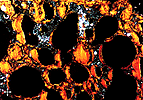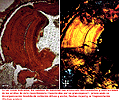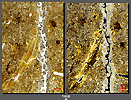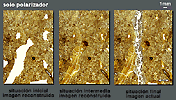![]() Optical properties of illuvial
clay coatings
Optical properties of illuvial
clay coatings
Continuation
The characteristics by which the illuvial origin of clay is recognised in thin sections are: optical continuity, preferred strong orientation, intense interference colour, existence of laminations, textural contrast with the adjacent matrix, abrupt limit with the surrounding material (in both parallel and crossed nicols), own natural colour and localised, covering the walls of macrovoids or the surfaces of aggregates. But it will not always show all these characteristics and therefore a limited number of these features can be present in every situation.
![]() Localisation. As
the illuvial clay accumulations are produced by the immobilisation of suspensions,
these are locally present in soils, related to the large voids (although in
dynamic horizons they may change to be incorporated in the soil mass). They
are found forming more or less thick pellicles,
Localisation. As
the illuvial clay accumulations are produced by the immobilisation of suspensions,
these are locally present in soils, related to the large voids (although in
dynamic horizons they may change to be incorporated in the soil mass). They
are found forming more or less thick pellicles,
coating the walls of macrovoids 
In general, it is not always easy to judge if a certain oriented clay domain is illuvial or not, but perhaps the microscope is the main tool in the identification of the clay transformation. This figure shows a series of microscopic fields in which the recognition of the illuvial origin of the clay is becoming more and more problematic.
Difficulties in the recognition of illuvial
clay coatings by means of the petrographic microscope are due
to two different situations.
![]() On the one hand, there is the pellicles' own
stability, which will regulate their permanence (clay coatings can be destroyed
after a while, mixing with the soil mass and totally disappearing; humidity
changes that lead to swellings and contractions, the precipitation of carbonates
and biotic activity are the most frequent causes).
On the one hand, there is the pellicles' own
stability, which will regulate their permanence (clay coatings can be destroyed
after a while, mixing with the soil mass and totally disappearing; humidity
changes that lead to swellings and contractions, the precipitation of carbonates
and biotic activity are the most frequent causes).

The following images reproduce an illuvial clay infilling that has been deformed by a later carbonate accumulation.


![]() And on the other hand there may be confusion
problems with other clay coatings and clayey domains with very different origins.
The most common confusion problem of illuvial clay is the clay coatings oriented by pressure, originating from contraction
and swelling processes due to humidity changes in the soil. In general, these
coatings have less orientation, they do not have microlaminations and do not
have clear boundaries (figure).
And on the other hand there may be confusion
problems with other clay coatings and clayey domains with very different origins.
The most common confusion problem of illuvial clay is the clay coatings oriented by pressure, originating from contraction
and swelling processes due to humidity changes in the soil. In general, these
coatings have less orientation, they do not have microlaminations and do not
have clear boundaries (figure).
Below there are a series of examples of illuvial clay accumulations.
To summarise, the correct recognition of the
illuvial process is a very important fact and its wrong diagnosis
is the most frequent cause of mistaken interpretations in the
study of soils. Coatings with illuvial origin are, in general,
very difficult to differentiate in field studies, but easy to
differentiate, most of the time, in microscopic studies.